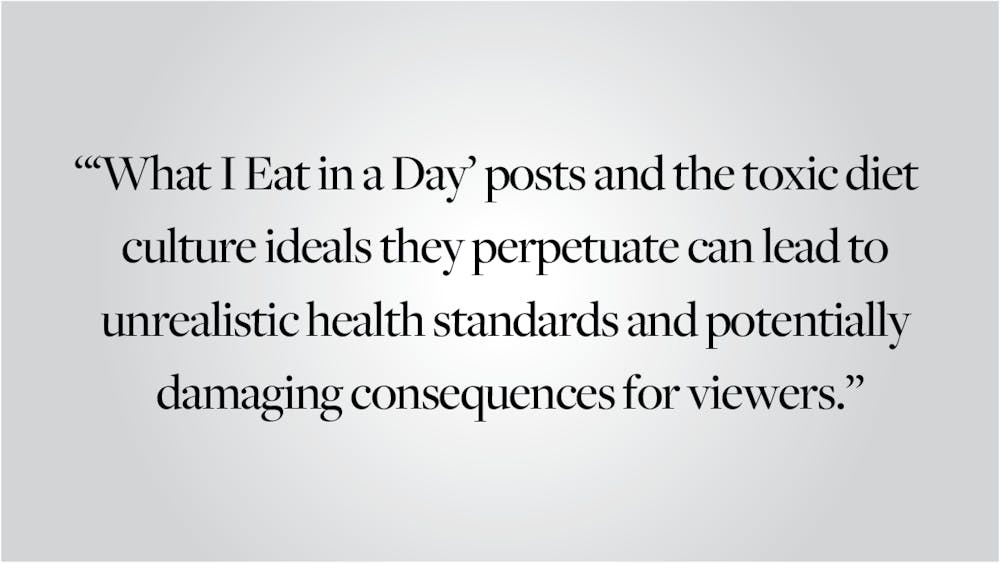The videos are all the same: A thin, conventionally attractive person poses in front of a mirror before the screen cuts to a beautifully staged bowl of oatmeal. The next shot is lunch, a colorful salad, and then dinner, a mix of grains and greens. Bonus points if “macros”— the grams of carbohydrates, protein and fat — are featured in the caption below.
I scrolled through dozens of these “What I Eat in a Day” posts on Instagram Reels during the pandemic, vicariously living the life of wealthy, 25-year-old health influencers. Everything seemed so clean, green and perfect. If only I could just eat oats and protein bars and go to the gym like them!
However, social media rarely shows the whole truth. In reality, the superficially healthy lifestyle promoted by social media's food influencers is hardly perfect. Although seemingly harmless and entertaining, “What I Eat in a Day” posts and the toxic diet culture ideals they perpetuate can lead to unrealistic health standards and potentially damaging consequences for viewers.
Seeing what someone else is eating naturally invites comparison between the viewer and the content creator’s diets. Constant comparison, especially when the creator’s diet is unattainable or unrealistic, may lead to dissatisfaction and lower self-esteem. Both factors have been linked to eating disorders and disordered eating habits.
Sarah Adler, a clinical psychologist and associate professor at Stanford University’s Department of Psychiatry, noted in a Huffington Post interview that “the visual image of a smaller-bodied person is enough to lead people to compare themselves to it. The human brain is hard-wired to make comparisons, regardless of how healthy or unhealthy our relationship is with food.” When social media’s definition of health is being thin and consuming green smoothies each day for breakfast, such comparisons can be particularly problematic, as each person’s nutritional needs are different.
Social media’s version of health also omits foods that carry cultural relevance for millions of people, as the vast majority of health influencers are white. The lack of representation of cultural foods can lead individuals to believe that those dishes are not part of a balanced diet, even when such foods are nutritionally valuable and help connect individuals to their familial histories and traditions.
Further, the authoritative voice many popular health influencers utilize when broadcasting nutritional advice contributes to a flawed cause-and-effect relationship between diet and physical appearance. When an influencer shows off a thin, toned body at the beginning of a meal plan post, it is insinuated that following the influencer’s diet plan will lead a person towards a conventionally attractive body type. This may lead individuals to replicate influencers’ diets at the cost of their own nutritional needs.
The science behind health and diet is complex, with much research still debating the relationship between diet, body type and health. What is clear, though, is that nutrition is highly individualized and cannot be easily copied and pasted from one person to another. People of different genders, ages, health backgrounds and social situations all have different needs when it comes to eating. “What I Eat in a Day” posts and social media health culture both disregard the complexity of these individual dietary needs and prescribe a one-size-fits-all treatment for health. These videos are not only unrealistic for those who cannot access the same food or lifestyle choices as social media health influencers, but are potentially physically and mentally harmful as well.
Perhaps the most concerning aspect of the recent proliferation of “What I Eat in a Day” videos is the lack of scientific research to back up the many promises of weight loss and growth of lean muscle mass they include. Even though a diet regimen may not be specifically promoted in “What I Eat in a Day” posts, titles such as “What I ate today to lose weight” followed by a paragraph of health advice naturally position content creators as the arbiter of nutritional information, even when the influencer is basing health advice on anecdotal evidence.
This trend is pervasive throughout the health space on social media. A study by a team at the University of Glasgow in 2019 found that the majority of health bloggers in the United Kingdom “could not be considered credible sources of weight management information.” The possibility of misinforming large audiences is significantly concerning considering the impressionable young age of many Instagram users, who may be more vulnerable to adopting poor eating habits in pursuit of following the advice of a famous health influencer.
Ultimately, viewers of “What I Eat in a Day” posts must be sure to view them with awareness of the information the content creator is spreading and the potential negative effects of the content, especially if the viewer has a history of an eating disorder or disordered eating habits. In an interview for Well + Good, registered dietitian Isabel Vasquez recommends “noticing what thoughts the videos bring up,” self-reflecting and reframing negative thoughts in a “more positive light, whether it be celebrating cultural foods or showing compassion towards (oneself).”
On the creator's side, social media influencers must be aware of their platforms, audiences, educational backgrounds and the potentially damaging impact of the content they create for social media users. Often, it can be better to say nothing at all, especially when one does not have the proper educational background to give nutritional advice. Food choices do not dictate health or happiness, and to advance that idea is a massive oversimplification of what health means to each individual person. So go forth, have your cake and eat it too.
Juliet Fang ’26 can be reached at juliet_fang@brown.edu. Please send responses to this opinion to letters@browndailyherald.com and other op-eds to opinions@browndailyherald.com.
Juliet Fang is a second year at Brown studying Ecology and Evolutionary Biology. In her free time, she enjoys running, cycling, and watching duck videos.





